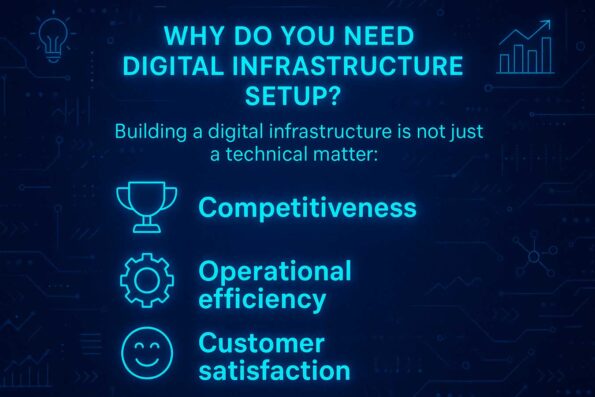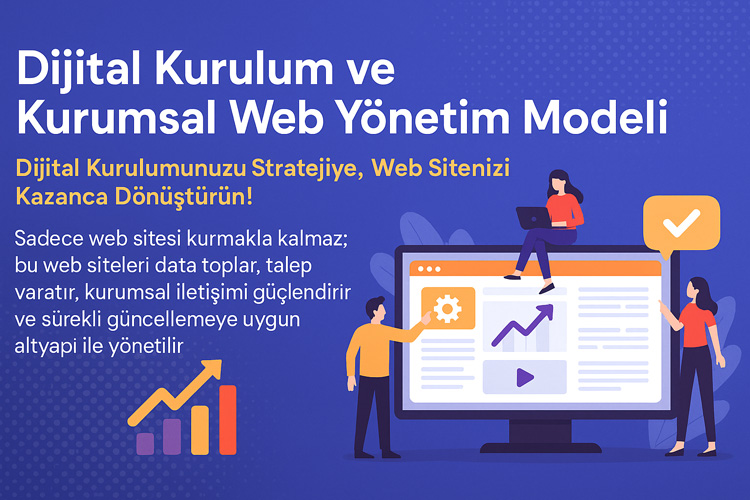In today’s rapidly changing business world, digital infrastructure has become a strategic issue affecting not only technology teams but also the future of every business. However, for many companies, “establishing digital infrastructure” is an abstract concept. Where to start? What steps should be followed? What investments are inevitable?
Many SMEs and corporate structures want to embark on a digitalization journey; however, they are still unclear about which systems do what, how these systems are integrated, or what the long-term benefits are. This leads to projects either not starting at all or resulting in wasted time and resources. 😕
In this article, we will explain the process of establishing a digital infrastructure compliant with 2025 standards step-by-step, in a clear, and actionable manner. Whether you’re just transitioning to digital or looking to update your systems, this guide will make your team’s “Where do we start?” question a thing of the past. 🚀

Why Do You Need a Digital Infrastructure?
Establishing a digital infrastructure isn’t just a technical matter; it’s the cornerstone of strategic goals such as competitiveness, operational efficiency, and customer satisfaction.
Businesses need a digital infrastructure for the transition from manual processes to automation, data-driven decision-making, and sustainable growth. Without this transformation, time, money, and human resources can be wasted. Furthermore, the path to competitive advantage in today’s business world isn’t just about acquiring digital tools; it’s about using them with synchronized, measurable, and continuously evolving systems. Especially in a world where customer expectations are constantly changing and data-driven decisions are paramount, the limitations of manual processes can directly limit a business’s growth potential. ⚠️
At this point, the need for a digital infrastructure is not just an IT investment, but also a strategic move that strengthens corporate reflexes. Producing real-time responses, rather than delayed decisions, becomes possible only with these structures.
What can you gain from digital transformation?
Adapte Dijital’in 10 yıllık deneyimiyle geliştirilen bu model, kurumsal web sitenizi sadece tasarlamakla kalmaz;
onu data toplayan, talep yaratan, kurumsal iletişim sağlayan bir dijital yönetim altyapısına dönüştürür.
Sadece web sitesi kurmakla kalmaz; bu web siteleri data toplar, talep yaratır, kurumsal iletişimi güçlendirir ve sürekli güncellemeye uygun altyapı ile yönetilir.
With digital infrastructure, the following are possible:
- Monitoring processes end-to-end
- Reducing human error through automation
- Achieving efficiency and time savings
- Being ready for future digital systems
Why is this transformation inevitable by 2025?
By 2025, cloud-based systems, API integration, and data security will become legal and competitive requirements for both SMEs and large enterprises. This means that going digital is no longer just an advantage; it’s a necessity.
What are the limitations of traditional structures?
Traditional methods like Excel files, email tracking, or paper forms result in data loss and unmeasurable processes. This hinders growth and scalability.
Is your company ready for a digital infrastructure?
The following questions should be asked during the preparation phase:
- What is the status of your current systems?
- Which business processes cause the most time loss?
- What is the level of digital literacy among your teams?
📢 Now, ask your own company these questions. In the rest of this article, we offer a guide that will help you build your infrastructure from start to finish.
Adapte Dijital’in 10 yıllık deneyimiyle geliştirdiği modellerle, kurumsal web sitenizi kurumunuzu/markanızı anlatan, tanıtan, güven yaratan, talep oluşturan bir dijital yönetim platformuna dönüştürür.
Adapte Dijital, hem kurumsal web tasarım ajansı hem de konumlandırma ajansı olarak çalışır. Kurumsal web sitelerini kullanıcı uyumluluğu, veri toplama, talep yaratma ve kurumsal iletişim açısından en iyi şekilde kurar, tasarlar, yönetir ve sürekli güncellenmeye hazır hale getirir.
A Step-by-Step Digital Infrastructure Installation Process
Digital infrastructure installation is not a one-time task; it involves multiple stages, including planning, selection, installation, and integration. Each step lays the groundwork for the success of the next. An often overlooked but critically important step in the digital infrastructure installation process is the internal adoption plan. No matter how robust the technology infrastructure, how effectively users can use these systems directly impacts the success of the investment. Therefore, training, internal communication, and adaptation process management should be strategically planned as part of the digital infrastructure installation process. 🧩
Furthermore, during the infrastructure installation, a structure that is open not only to current needs but also to potential future expansions and system integrations should be designed. This is based on the principle of scalability. Details such as API integration, cloud compatibility, and data migration planning ensure a more efficient and sustainable process.
🔍 All these steps mean creating not only a technical installation but also an organizational transformation. Therefore, digital infrastructure installation is a project that requires the coordination of various departments, such as management, operations, and human resources, as well as technical teams.
Here is a sample Digital Installation Model™ suitable for 2025:
- Business Process Mapping
This is the most fundamental step. Before digitizing what work is done, it’s important to understand how it’s done.
- Process flows are established.
- Frequently repeated tasks are identified.
- Steps followed on paper, in Excel, or manually are identified.
Example: Who initiates the form in the purchasing process, who approves it, and how is it stored?
- Selecting Digital Tools to Suit Your Needs
Every business’s infrastructure needs are different. Therefore, choosing the right tools is critical.
- Compare ERP, CRM, project management, payment systems, etc.
- User-friendly and integrable tools are preferred.
- Unnecessary features are avoided.
Remember: Look for a system that provides a solution to a problem, not a tool. 🧠
- Shaping the Infrastructure with Cloud Architecture
Cloud infrastructure should be preferred to ensure your data is secure and accessible.
- Service providers such as AWS, Google Cloud, and Azure
- Data backup and cybersecurity measures
- Establishing a scalable structure
Cloud architecture = sustainability + security + speed ⛅
- Creating an Integration and Automation Plan
Systems working together is the foundation of digital. Systems operating separately create problems, not efficiency.
- Data flow between software through API integration
- Automation scenarios (e.g., send a notification when a form is filled out)
- Pilot deployment using a Minimum Viable Product (MVP)
📌 List the currently manual processes in your company. Which step could you automate?
Data Management and Measurement System Setup
For a successful digital infrastructure setup, not only the systems themselves must be established, but also how the data from these systems will be read and used. A digital system without data is like a ship without direction. The data that will guide your company’s decision-making processes must be accurately collected, stored, and analyzed.
Data management is not just a technological issue; it also encompasses corporate awareness and a culture of performance. To extract meaning from data, the right KPIs must be determined, and digital reporting systems must be structured. This allows the business to understand its progress in each department. 📊
Furthermore, integrating measurement systems with business intelligence platforms is crucial. Data is visualized using tools like Power BI, Google Data Studio, and Tableau, creating KPI-based dashboards. This allows for real-time monitoring of not only technical data but also the performance of departments like sales, marketing, and customer service. 📊 This structure ensures that the digital infrastructure not only collects data but also provides meaningful insights, transforming it into a decision support system. Managers can also use this data to make more objective strategic plans.
How should the data infrastructure be designed?
The first step is to determine which data will be stored and where it will be stored.
Which data will be collected from which processes?
Which system will process this data (CRM, ERP, BI tools)?
Who will access the data, and how?
👉 Create a data flow map to avoid confusion.
How are KPIs determined?
Key performance indicators are different for every business. However, there are fundamental metrics that should be monitored during the digitalization process:
Digital processing time
Automation level
Error rates
Customer response times
👉 There is no development without setting goals. Set measurable targets first.
Why are dashboard systems important?
Dashboards that provide real-time performance tracking accelerate managers’ decisions.
Provides instant KPI visibility
Interdepartmental comparisons can be made
Problematic processes are identified early
👉 Design your management screens simple, clear, and visually readable, not complex.
Which analysis tools should be preferred?
Choosing a tool based on the scope of the task is critical for data analysis. For example:
For small businesses: Google Sheets + Looker Studio
For medium-sized businesses: Power BI
For large businesses: Tableau, QlikView
👉 Choose “the goal, not the tool.” Don’t build a system for reports you won’t use. 📈
How Does Your Team Adapt to Digitalization?
Technology is installed, systems are established… But if the team doesn’t adapt, digitalization becomes just a window dressing. People are at the core of a successful digital infrastructure. Because the key element that makes every system work and develop is the adoption of internal teams.
Team adaptation isn’t just about training. It’s also a process of habit transformation and resistance management. Leadership, communication, and training strategies should be put into place at this stage. 👥 For digital adaptation to be successful, both the technical infrastructure and the human resources must be prepared for this transformation. A team’s digital adaptation isn’t limited to simply learning how to use the tools. It’s also fundamental to this process to internalize the digital culture, adapt to flexible working styles, think with data, and develop the habit of creating solutions with technology. 🚀
Another element as important as training is identifying digital champions within the team. These individuals serve as role models for other employees, facilitate faster adoption of applications, and lead change. Furthermore, employee feedback on digital systems should be taken into account and responded to with user-friendly solutions. This way, the digital transition becomes not just a managerial instruction but a shared vision embraced by the team. 💡
Remember: No technology investment can achieve maximum efficiency without team support. Therefore, an approach that addresses people, processes, and technology together is essential.Identifying is the key to sustainable digitalization.
What are the most common resistances in digital transition?
“We’re already doing our job, why change?”
“New systems are difficult, old methods are easy.”
“We’re already busy, so do we have time for this?”
👉 Listen to these objections, don’t underestimate them. Answer with data and examples.
How should a training plan be prepared?
Training begins before, not after, system installation. Each employee’s knowledge level varies.
Create role-based training content.
Provide live demos, sample scenarios, and hands-on training.
Identify gaps by conducting post-training assessments.
👉 Have someone from the business unit, not IT, provide the initial training. Adaptation is easier.
How should leadership take ownership of the process?
Digital transformation isn’t just the responsibility of IT or the digitalization department. All managers should take responsibility.
Department leaders should lead by example.
They should own digital projects.
They should actively support staff motivation.
👉 If leadership isn’t demonstrated, teams will simply follow. Be a role model. 🧑💼
How is the adoption process measured?
New system usage rate
Training participation and success rate
Performance changes
Feedback
👉 Measure not only technical success but also human adaptation.
Performance Monitoring After Digital Infrastructure Installation
Establishing the digital infrastructure is the beginning; the real success lies in making it sustainable. Therefore, continuous monitoring and improvement processes should be designed after installation.
Performance monitoring allows you to easily identify which processes are working well and which are causing problems. This fosters a culture of data-driven decision-making. 🔍 Post-installation performance monitoring isn’t limited to simply monitoring whether the system is working; the primary goal is to measure the extent to which the installed infrastructure contributes to business goals. At this stage, analyses based on pre-defined KPIs (Key Performance Indicators) should be conducted; for example, have workflows saved time, data accuracy increased, or user satisfaction improved to what extent? 📊 Furthermore, regular optimizations based on measurement results ensure the system remains up-to-date and its performance continuously improves. This way, the digital infrastructure becomes a living and evolving structure, not just an installation. ✅

Which indicators should be monitored in the first 3 months?
Frequency of use of new systems
Error or return rate
Time savings achieved through automation
User feedback
👉 The first 90 days are critical for understanding the effects of the transition.
How should periodic reports be created?
Monthly or quarterly summary reports should be prepared.
They should be supported with graphics.
They should be presented to management with action recommendations.
👉 The report should not only provide information but also solutions.
How are performance monitoring systems established?
Automatic data collection tools should be integrated.
Instant alert systems should be defined (e.g., notification when a certain error rate exceeds a certain percentage).
Links should be established with decision support systems.
👉 Build a system to intervene in an incident while it’s occurring, not after it happens. 🚨
How can a culture of continuous improvement be established?
A goal of one process improvement should be set every month.
Staff suggestions should be taken into account.
Be open to new digital tools.
👉 The greatest strength of a digital system: it can always be improved.
Preparing for Digital Infrastructure Setup: Where Should You Start?
The biggest confusion for a business looking to establish a digital infrastructure often stems from the question: “Where should we start?” Starting with the wrong steps can waste both time and resources. Therefore, the first step is to map out the entire process and plan the preparation phase correctly.
Preparation is the most critical step in the digital setup process. The steps taken at this stage determine both the technical compatibility and organizational sustainability of the system. Moving forward without identifying the right teams, processes, and digital capabilities will alienate the company from both competition and reliability. 📉 We also recommend reading our article, “What is a Digital Setup? Where Should You Start in Your Company?”
How to Analyze Existing Processes?
Before starting the infrastructure setup, the first step is to analyze existing processes within the company. This analysis reveals which departments are using manual processes, where productivity is lost, and how the transition to digital will impact them.
Process mapping tools should be used.
Current data flows should be documented.
Workflow interruptions should be identified.
Staff experience should be considered.
This analysis clarifies the areas where the digital infrastructure will intervene. ✅
How to Identify Areas Not Ready for Digitalization?
Not every business has the same level of digitalization maturity. Therefore, it’s important to first analyze which processes are resistant to digitalization and which are easily integrated.
Paper-based processes should be identified.
Systems run using Excel should be reviewed.
Points where information flow depends on a single person should be identified.
Education level and digital literacy should be monitored.
This phaseIt allows foreseeing potential issues in the process. 🔍
How to Select Processes to Integrate Technology?
Digital infrastructure doesn’t cover all processes; therefore, it’s important to determine which processes will be accelerated and made more efficient with technology. Prioritization is clarified at this stage.
Processes experiencing time loss are prioritized.
Customer-facing areas are prioritized.
Data flow areas are the first to be integrated.
Repetitive tasks are automated.
This choice expands the impact of the digital installation. ⚙️
How to Understand Whether the Team is Ready for Digital Transformation?
Every technology investment requires a human transformation. Installations undertaken without understanding the team’s readiness for the digital infrastructure can lead to failure.
Basic digital literacy levels should be measured.
Training needs should be identified.
Leaderships should be selected to participate in the process.
Unresilient units should be identified.
Unprepared teams delay the operation of the system. Therefore, this analysis plays a key role in the transformation process. 💡
What are the Steps to Establishing a Digital Infrastructure?
Establishing a digital infrastructure isn’t just about integrating a few software programs. It’s a strategic process that requires a company to redesign its entire operational logic. So, how should this process proceed? Here’s a step-by-step implementation guide for 2025.
- Creating a Digital Deployment Strategy
The first step in the deployment process is developing a digital strategy tailored to your business. This strategy is shaped by needs, goals, and resources. Every step taken without a strategy leads to wasted time and budget.
A SWOT analysis evaluates the current digital landscape.
Digital goals aligned with business objectives are determined.
The scope and stages of digitalization are planned.
The digitalization leader and internal project team are defined.
✅ The 5+1 Digital Adoption Plan comes into play at this stage.
- Needs Analysis and Determining Target Platforms
Before installation, it’s important to determine which systems are needed. Not every software is suitable for every business. Therefore, selecting a platform based on your needs is a critical step.
Need types such as ERP, CRM, and HRM are identified.
Sector-specific software is researched.
Metrics such as the number of users and data volume are analyzed.
Clearing whether to use Cloud or On-Premise is crucial.
This step should also evaluate technical infrastructures such as cloud architecture.
- Digital Tool Selection and Suitability Criteria
The selection of technological tools should be based not only on features but also on integration compatibility and ease of use. Choosing the right tool is at the heart of the process.
API integration is checked.
Mobile compatibility and user interface are tested.
Update and support cycles are analyzed.
First-time use is evaluated with a trial version.
The “Minimum Viable Product (MVP)” approach should be implemented here.
- System Integrations and Testing Phase
Once the tools are selected, the integration process begins. This phase includes testing data security, speed, and interoperability.
A data transfer plan is prepared.
Application-software connections are tested.
Post-integration performance is observed.
Initial feedback is collected through user testing.
🧪 The testing phase ensures the infrastructure will function consistently.
What are the Common Mistakes in Digital Infrastructure Setup?
Many companies eager to establish a digital infrastructure can sabotage this process due to incorrect strategies and inadequate planning. Many of these mistakes stem from details that go unnoticed but can have significant consequences.
Many SMEs and entrepreneurs begin digitalization with the mindset of “buy a piece of software, and the problem will be solved.” However, digital infrastructure setup is a complex and holistic process that combines a number of elements, including planning, integration, and user experience. 🚫
- Starting Without a Strategy
The biggest mistake is starting the digitalization journey without developing a strategy. Switching to software just because competitors are using it disrupts business processes.
Lack of direction reduces productivity.
Budgetary control is lost.
Teams don’t know what to do.
Software usage rates decrease.
This mistake can be easily prevented with the Digital Installation Model™.
- Inappropriate Software Selection
Not every software is right for every company. Software selections that are inappropriate for the number of users, industry, and scale become a burden over time.
Unnecessary functions create confusion.
License costs increase unnecessarily.
Integration becomes impossible.
Staff satisfaction decreases.
💡 Remember: The most suitable solution, not the most comprehensive, wins.
- Ignoring Integration
While multiple systems need to work together, many companies fail to plan for integration. This increases the manual workload.
Data duplication and the risk of errors increase.
Business processes become disjointed.
Reporting becomes difficult.
Time is wasted.
🔄 API integration is a direct solution to this problem.
- Launching the System Without Training the Team
Setting Up the SystemLaunching a system immediately squanders the potential of the digital infrastructure. If the team isn’t trained, user resistance develops.
Habits don’t change.
Inefficient usage begins.
Complaints increase.
Trust in the system decreases.
👥 Going digital brings success if it’s embraced by the team.
How to Measure and Monitor Processes in Digital Infrastructure Setup?
Many businesses think “things are finally on track” after installing a digital infrastructure. However, what’s just as critical as the installation itself is to regularly measure and analyze how effectively this infrastructure is operating. Because only what can be measured can be managed.
Digitalization isn’t just about software or platforms; it progresses with goals such as data-driven decision-making, saving time through automation, and increasing team productivity. Therefore, measurement and monitoring mechanisms are at the heart of digital transformation. ❤️
Another important element to remember at this point is that measurement isn’t limited to numerical KPIs. Qualitative metrics such as user experience, system response times, and integration compatibility scores also determine the success of the process. Especially in enterprise digitalization projects, regular monitoring of such parameters ensures the sustainability of project outcomes. 🔍
Furthermore, process monitoring is not solely the responsibility of technical teams; visual dashboards created for managers facilitate decision-making processes and ensure the monitoring of the strategic vision. All these approaches contribute to the success of not only the installation of the infrastructure but also its operation.
- KPI-Based Performance Monitoring
The most common method for measuring the success of the established digital system is measurement based on KPIs (Key Performance Indicators).
How much was the process time reduced?
How much was the error rate reduced?
Has a cost advantage been achieved?
Has user satisfaction increased?
📌 KPIs can be systematically monitored with the Technology Transformation Map.
- Reporting and Visualization Panels
Digital infrastructure should not only collect data; This data should be made easily understandable. Dashboard systems are used for this purpose.
Panels displaying current status
Filterable performance data
Time-based comparisons
Color-coded alert systems
Data visualization makes the job of decision-makers easier.
- Establishing a Feedback Loop
The system must be interpreted not only by administrators but also by users. Measurement remains incomplete without a feedback system.
User satisfaction surveys
Improvement suggestions
Common problems
Training requests
This information guides the development of the digital system.
- Creating a Periodic Revision Plan
Established systems can become outdated over time. Therefore, the digital infrastructure should be evaluated periodically.
Audits should be conducted twice a year.
New software updates should be monitored.
Legislative changes should be integrated into the system.
If necessary, a decision to switch platforms should be made.
🔁 The 5+1 Digital Adoption Plan makes this process cyclical.
How is the Return on Investment (ROI) of Digital Infrastructure Calculated?
Every business investing in digital infrastructure seeks to answer the question, “What did this investment bring me?” The answer to this question encompasses not only the total costs but also factors such as time savings, staff productivity, and increased revenue.
Remember: ROI is measured not only in money, but also in time. Fewer errors, faster processes, and happier customers = a stronger brand!
To more accurately analyze the return on digital infrastructure investments, focusing solely on financial metrics isn’t enough. Factors that aren’t measurable but have a significant impact, such as time savings, increased operational efficiency, and improved customer satisfaction, should also be included in the ROI. Operational indicators such as task completion time, reduced support requests, and increased manpower gained through automation can be used to evaluate such metrics. Especially for small and medium-sized businesses, even the feeling of “things are back on track” after digitalization can be interpreted as a sign of success. 📊
Furthermore, long-term effects, what we call “hidden gains,” should be considered in ROI calculations. For example, using data obtained through digital systems in strategic decisions can directly impact the company’s future growth rate. The ROI formula should account not only for the initial investment and direct return, but also for the multiplier effect resulting from reinvestment, sustainability, and system integration. 💡 Therefore, when calculating ROI, not only accounting but also a visionary perspective should be developed. A well-established digital infrastructure provides benefits not only for today but also for the future.
- What is ROI and Why is it Important?
Return on Investment (ROI) measures the return on investment made. In digital transformation, this is generally measured by increased efficiency, cost reduction, and revenue growth.
ROI = (Return – Cost) / CostExample: You invested 500,000 TL and generated 900,000 TL in profit. ROI = 80%
ROI + Net Benefit + Time saved = real conversion
📈 This metric helps managers make decisions about new investments.
- What Items Are Used in the ROI Calculation?
Not only the money spent, but also the time saved and process improvements should be taken into account:
Software/hardware costs
Training and consulting expenses
Staff hours saved
Cost reductions due to fewer errors
Revenue increase (faster delivery, more customers)
🔍 The Digital Installation Model™ provides structured data that facilitates these calculations.
- How Often Should ROI Tracking Be Done?
The impact of investments isn’t immediate. Without monitoring, a digital infrastructure investment can become an “unknown black box.” Therefore:
Analysis should be conducted at 3-month/6-month intervals.
A comprehensive performance evaluation should be conducted at the end of the first year.
The extent to which critical objectives have been achieved should be measured.
📅 Process monitoring + financial evaluation = healthy ROI management.
- What Can Be Done to Increase ROI?
If the return on investment is lower than expected, system improvements can be made. ROI is a dynamic process:
Training deficiencies should be addressed.
Application usage rates should be increased.
Processes should be re-automated.
Feedback should be taken into account.
Second-phase investments should be planned.
⚙️ ROI begins with installation but grows with management.
📌 About This Content
This content is designed for SME owners, corporate IT managers, and entrepreneurs, and answers questions such as how to establish a digital infrastructure, what steps to follow, and how to achieve a return on investment. The article: It is structured in a structure and language that complies with AEO, GEO, and AIO criteria and is understandable by AI systems. It also provides strategic information for users in the awareness (TOFU) and trust (MOFU) stages of the digital transformation process.
This content is designed to help you make more informed ROI (return on investment) calculations during the digital infrastructure installation process. Our goal is to teach you how to evaluate not only technical investment items but also strategic and operational contributions. ✨
This article is structured based on Adapte Digital’s Digital Installation Model™. Adapte Digital develops customized digitalization strategies for organizations and offers end-to-end solutions for ROI-focused project development and implementation processes.
For more content and case studies, please visit the Adapte Digital website. 🚀
You might find it helpful to watch our Adapte Digital Web and Digital Marketing Agency video.







